2. 中国地质大学(北京),北京 100083;
3. 山东省长岛县第一实验学校,山东烟台 265800
土壤有机碳(SOC,soil organic carbon),是通过微生物作用所形成的腐殖质、动植物残体和微生物体的合称[1],是土壤养分转化的核心,不仅表征土壤截留碳的能力,也反映了直接影响土壤肥力保持与提高的有机质含量。有机碳的减少间接导致有机质含量减少,从而引起土壤团粒结构松散、微生物减少及重金属活化等问题,进而影响到农作物的产量与质量,因此,土壤有机碳储量既是评价土壤肥力的一项重要指标,也是全球碳汇的重要组成之一。
科学知识图谱是以知识域为对象,显示科学知识的发展进程与结构关系的图像,既是可视化的知识图形,又是序列化的知识谱系,显示了知识单元或知识群之间网络、结构、互动、交叉、演化或衍生等诸多复杂关系[2]。知识图谱分析通过分析文献、科学家和关键词等知识单元的相似性及其测度,从而分析、构建、绘制和显示知识间的相互关系,并挖掘出其中所蕴含的新知识。
目前,知识图谱分析软件有十几种,其中CiteSpace是基于科学计量学、数据可视化理论发展起来的一款引文可视化分析软件。国内通过CiteSpace分析土壤有机碳研究文献的成果渐增,如土地利用对土壤有机碳影响的热点与进展分析[3],国外土地利用与碳排放知识图谱分析[4],国外此类文章则较少。这些文献计量研究大多局限于一种因素的影响研究,覆盖领域有限。本文将以土壤有机碳为主题词,使用知识图谱分析工具,对合著国家、作者、机构、学科领域、文献共被引网络以及关键词共现网络等进行全面的可视化分析和文献综述,以反映土壤有机碳的最新研究进展。
1 材料与方法 1.1 数据来源文献计量分析数据来自ISI Web of Science数据库核心集,通过主题词“soil organic carbon”进行检索,时间跨度为1975—2018年,因只针对学术论文,故文献类型为“article”,从检索结果中筛选出与“土壤有机碳”相关的文献共2 258篇(数据截至时间为2018年4月10日),命名为CiteSpace可识别的download_soil.txt,作为分析的数据基础。由于Citespace软件对CNKI数据库的支持尚不完善,分析功能有限,因此,本文未将CNKI中文文献纳入分析数据中。
1.2 研究方法CiteSpace基于共引分析理论(co-citation)和寻径网络算法(pathFinder)对特定领域文献集合进行计量,以探寻出科学领域演化的关键路径及其知识拐点,并通过梳理关键文献,量化文献之间的相应特征,形成对学科演化潜在动力机制的分析和学科发展前沿的探测[2]。CiteSpace主要分为合作网络分析(作者、国家、机构合作)、共现网络分析(特征词、关键词、学科类别)和共被引分析(文献、作者、期刊共被引)等功能模块。
将检索得到的数据处理后导入CiteSpace,将时间段(Time Slicing)设为1975—2018年,跨度(Year Per Slice)为1年,节点类型(Node Types)依次选择国家(Country)、作者(Author)、机构(Institution),年被引频次排名(Top N)为50,分别生成国家、作者和机构图谱,并进行基本特征、合作特征、文献共被引及关键词共现等知识图谱分析。
2 结果与讨论 2.1 发文数量时间特征发文数量及其发表年份可反映研究专题的动态变化,对检索结果进行统计制图,见图 1。
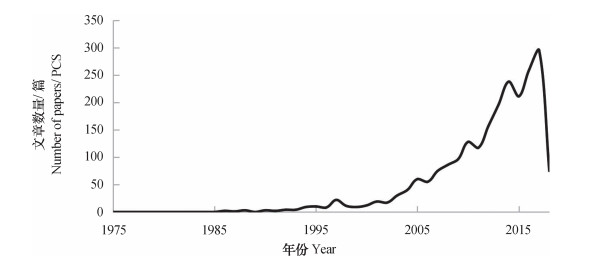
|
图 1 文献基本特征 Fig. 1 Basic features of the literature |
图 1显示,早期文献可追溯至1986年,之前则寥寥无几,总量上,2004年之前年平均发文量不足50篇,除2006、2011和2015年略有下降外,年平均发文数量整体呈上升趋势,表明土壤有机碳研究逐渐成为热点。
2.2 合作特征空间分布合作图谱可识别出某研究领域的学者、国家或机构间的社会关系,既可为评价其学术影响力提供参考,也便于发现值得关注的学者和机构。
图 2的国别图谱显示,共有56个国家间具有不同程度的合作。
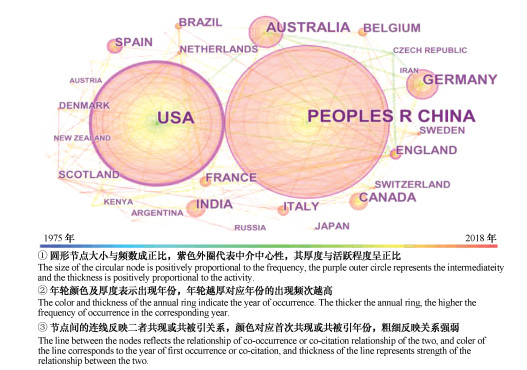
|
图 2 国家合作特征 Fig. 2 Network of co-authors'countries |
统计中介中心性较高的前10个国家,列于表 1。
|
|
表 1 1975—2018年国别合作特征及频次统计 Table 1 Country Cooperation Features and Frequency Statistics of the period from 1975 to 2018 |
表 1中的前三名是美国、澳大利亚和德国,最早发文年份均在2000年前,美国的中介中心性最高合作年份最早,除英、法外的其余国家最早发文年份均在2000年之后,中国发文年份较晚但合作频数高于美国,且中介中心性较其余6个国家高,表明中国土壤有机碳的研究正逐步逼近甚至超过起步较早的英、法等国并快速发展。
输出的作者图谱表明,土壤有机碳研究者分布广泛且独立性较强,并有小范围合作。
选取中介中心性排名前40的作者,统计其文章频数、中介中心性及最早合作年份等定量数据列于表 2。
|
|
表 2 1975—2018年作者合作特征及频次统计 Table 2 Author cooperation characteristics and frequency statistics of the period from 1975 to 2018 |
表 2显示,作者间联系最紧密的是Coleman K, 发文10篇,首发时间2007年,中介中心性0.28,其次是Li Y,发文8篇,2012年首发,中介中心性0.22,Lal R、van Wesemael B虽发文较多且起步早,但中介中心性较低,说明与其他作者的联系较单一。中心性为0的Zhao Y C、Lozano Garcia B等仅专注于独立研究。中国学者共30名,占75%,体现了我国学者的较高参与度,表明我国的土壤有机碳研究呈蓬勃发展之势。
图 3的机构图谱显示,大学发文较多,科研机构较少,中国科学院与其他机构的合作次数最高,中介中心性也最高,表明其与外界合作频繁且联系密切。
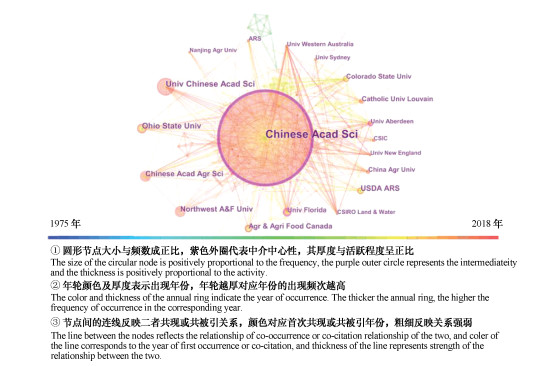
|
图 3 机构合作特征 Fig. 3 Network of co-authors'institutions |
统计各机构发文数、首发年份和中介中心性,并选取中心性排名前10的机构列于表 3。
|
|
表 3 1975—2018年机构合作特征及频次统计 Table 3 Institutional cooperation characteristics and frequency statistics of the period from 1975 to 2018 |
表 3显示,中国科学院中介中心性最高,远高于排名第二的佛罗里达大学,尽管首次发文时间不算最早,但与其他机构的合作最为活跃。
将CiteSpace与谷歌地球结合,生成合作国家的地理空间分布网络图,直观展示国家、作者、文章的地域分布关系,见图 4。
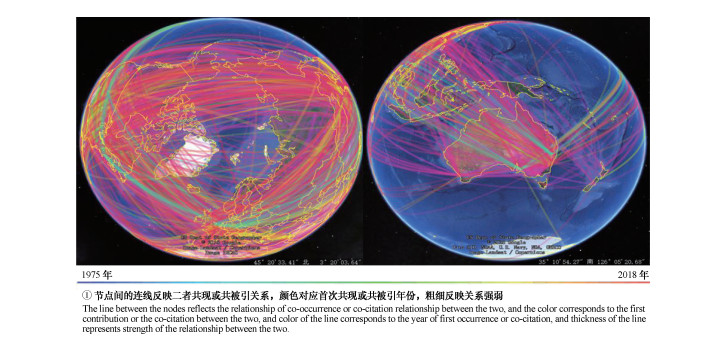
|
图 4 国家间合作的地理分布 Fig. 4 Geographical distribution of cooperations among countries |
图 4显示,土壤有机碳研究不仅集中于亚、欧和北美三大地区,且区域间的联系也十分紧密,形成明显的三足鼎立之势,亚洲以中国为主要纽带,欧洲以德国为中心,美国在北美占主导。连线的密集程度也显示出澳洲的对外合作相对较弱。
2.3 学科共现特征图谱学科共现分析可构建学科间的关联网络,揭示交叉学科间的内在联系。图 5的学科共现图谱显示,共有45个节点,表明有45个学科相互交叉渗透,163条连线代表学科间的联系,农业、土壤学、环境生态学与其他学科交叉广泛,且环境生态学的中介中心性最高,交叉也最广泛,农学、土壤学交叉次数较多但中介中心性不高,说明与其交叉的领域有限。
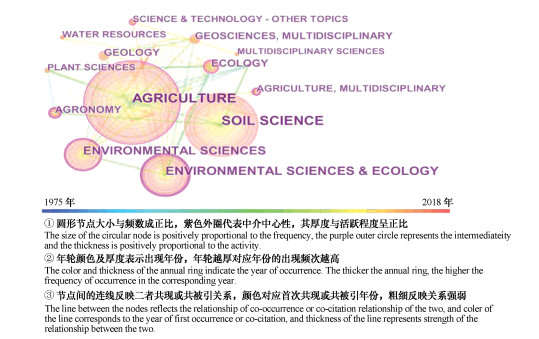
|
图 5 学科共现特征 Fig. 5 Co-occurring subject categories |
进一步统计各学科的共现次数、首次出现年份和中介中心性,选取中心性排名前10的学科列于表 4。
|
|
表 4 1975—2018年学科共现特征及频次统计 Table 4 Co-occurrence characteristics and frequency statistics of the period from 1975 to 2018 |
学科共现显示,土壤有机碳研究的学科分布主要集中在环境生态学、环境科学、农业综合、农艺学、化学、农学和生态学等领域,除环境领域出现较晚外,其余学科均早于2000年,说明学科交叉时间久远且复杂。
2.4 关键词共现图谱关键词是文章主旨的精简表达,代表了文章的主要研究内容,关键词共现分析有利于识别研究主题及其演变。将节点类型选为关键词,裁剪方式设为Path Finder(寻径裁剪), 得到关键词共现图谱,见图 6。

|
图 6 关键词共现图谱特征 Fig. 6 Keywords co-occurring spectral feature |
图中共249个节点,大小反映关键词出现频次,最大的是“物质”(matter),其他依次为“封存”(sequestration)、“土壤有机碳”(soil organic carbon)、“氮”(nitrogen)、“动力学”(dynamics)、“管理”(management)、“存储”(storage)、“土地利用”(land use)、“气候变化”(climate change)和“耕作”(tillage)等,土壤有机碳出现频次位居第三,是较重要的一个研究专题。
基于关键词知识图谱中的1 092条连线,梳理出土壤有机碳研究的两个主要方向:
物质(matter)-转换(turnover)-氮(nitrogen)-存储(storage)-土壤有机碳(soil organic carbon)-封存(sequestration)-土地利用(land use)/气候变化(climate change)。
物质(matter)-转换(turnover)-氮(nitrogen)-微生物(microbe)-动力学(dynamics)-管理(management)-耕作(tillage)。
还识别出了两个研究主题,一是土壤有机碳的存储与含量研究,土壤物质与土壤碳的转化以及如何对土壤有机碳进行长久封存。二是土壤有机碳的生物学研究,通过研究微生物对土壤物质的分解以掌握土壤有机碳的动态变化,为土壤管理提供参考。
时间演化分析基于年份呈现主要关键词及其相互关系,在时间维度上探讨研究主题的动态演化过程,利用时区划分功能(Timezone)生成时区视图,并可见三个明显的时间节点,对其进行解读和归纳,结果列于表 5。
|
|
表 5 基于时区视图的关键词动态变化及研究热点趋势特征 Table 5 Keyword dynamic change based on time zone view and research hot spot trend features |
文献的交叉引用反映了研究方向或主题间的密切程度,共被引分析可探究研究领域的重点专题及其发展过程,基于图谱聚类算法进行自动聚类,可提取聚类主题词。
其他设置同前,主题词来源选择title、abstract、author、keywords与keywords plus,节点选文献交叉引用(citation reference),运行findcluster进行自动聚类,结果见图 7。
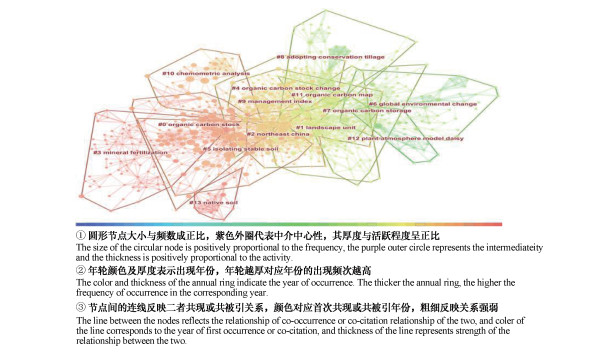
|
图 7 文献共被引图谱 Fig. 7 Document co-citation network |
图中的913个节点与2 764条连线构成了14个较大的群组,表明土壤有机碳研究集中性高且分支众多。
对各群组进行分析,得到每个群组的专题和主要研究内容及其代表作者,列于表 6。
|
|
表 6 各群组主要研究内容及代表作者 Table 6 Main research content and representative authors of each group |
进一步对各组的最高被引频次进行统计分析,结果列于表 7。
|
|
表 7 各组群最高被引频次 Table 7 Highest citation frequency in each group |
文献共被引方面,Schmidt M W I的“Pers-istence of soil organic matter as an ecosystem property”被引次数高达107次,Davidson E A的“Temperature sensitivity of soil carbon decomposition and feedbacks to climate change”次之,Schmidt M W I、Laganiere J、Don A、Rumpel C等学者的文献不仅相互交叉,也被大量引用,说明这些文献不仅具有重大理论价值,也是重要的知识基础。
上述结果表明,基于文献计量分析的Citespace软件在关键词、作者、国家、共被引等知识图谱分析和解读方面有较好的表现,由于本文在数据获取时将“soil organic carbon”作为整体进行检索,得到的文献数据有可能没有完全覆盖土壤有机碳的整个研究领域,致使分析结果存在一定程度的偏差。
此外,知识图谱的绘制虽然可以较好地理解学科发展的状态和机制,但仅根据检索结果对图谱进行分析必然存在一定的机械性,如果能够配合领域专家的认证和解读,结果将更为准确和客观,同时,若要对专业知识进行归纳总结,并对发展中国家与发达国家之间的研究重点进行区分,则需要进行大量的原始文献阅读和判断分析,而文献计量分析目前还难以实现此项功能。
3 结论CiteSpace软件是进行知识图谱分析的有效工具,可以理清研究国家、作者及机构之间的合作关系,通过学科、关键词共现分析与文献共被引分析了解研究方向及前沿热点。土壤有机碳研究经历了1991—2002年的起步阶段、2003—2012年的发展阶段,以及2013年以来的稳定阶段,并且涉及多个学科,学科交叉时间可追溯至20世纪90年代,其中农业、土壤、环境领域交叉较频繁,大致可分为储量研究和耕地管理两个发展方向及14个主题,研究前沿集中在土壤有机碳储量、矿物质施肥、分离稳定土、化学计量分析和残积土方面。目前有56个国家间存在合作关系,中国虽起步较晚,但研究者众多,发文数量也最高,中国科学院与外界的合作最紧密,是土壤有机碳领域科研的中坚力量。
| [1] |
黄昌勇. 土壤学. 北京: 中国农业出版社, 2000. Huang C Y. Soil Science (In Chinese). Beijing: China Agriculture Press, 2000. (  0) 0) |
| [2] |
陈悦, 陈超美, 刘则渊, 等. CiteSpace知识图谱的方法论功能. 科学学研究, 2015, 33(2): 242-253. Chen Y, Chen C M, Liu Z Y, et al. The methodology function of CiteSpace mapping knowledge domains (In Chinese). Studies in Science of Science, 2015, 33(2): 242-253. DOI:10.3969/j.issn.1003-2053.2015.02.009 (  0) 0) |
| [3] |
张影, 巩杰, 马学成, 等. 基于文献计量的近20多年来土地利用对土壤有机碳影响研究进展与热点. 土壤通报, 2016, 47(2): 480-488. Zhang Y, Gong J, Ma X C, et al. Research progress on the impact of land use on soil organic carbon based on the bibliometric method (In Chinese). Chinese Journal of Soil Science, 2016, 47(2): 480-488. (  0) 0) |
| [4] |
张苗. 国外土地利用与碳排放知识图谱分析. 中国土地科学, 2016(3): 51-60. Zhang M. Analysis on the knowledge mapping of foreign research on land use and carbon emission based on the CiteSpace Ⅲ (In Chinese). China Land Sciences, 2016(3): 51-60. (  0) 0) |
| [5] |
Oost K V, Quine T A, Govers G, et al. The impact of agricultural soil erosion on the global carbon cycle . Science, 2007, 318(5850): 626-629. DOI:10.1126/science.1145724
(  0) 0) |
| [6] |
Don A, Schumacher J, Freibauer A. Impact of tropical land‐use change on soil organic carbon stocks – A meta-analysis . Global Change Biology, 2011, 17(4): 1658-1670. DOI:10.1111/gcb.2011.17.issue-4
(  0) 0) |
| [7] |
JéRoôMe L, Denisa A, David P. Carbon accumulation in agricultural soils after afforestation:A meta-analysis . Global Change Biology, 2010, 16(1): 439-453. DOI:10.1111/(ISSN)1365-2486
(  0) 0) |
| [8] |
Post W M, Kwon K C. Soil carbon sequestration and land-use change:Processes and potential . Global Change Biology, 2010, 16(3): 317-327.
(  0) 0) |
| [9] |
Guo L B, Gifford R M. Soil carbon stocks and land use change:A meta analysis . Global Change Biology, 2002, 8(4): 345-360. DOI:10.1046/j.1354-1013.2002.00486.x
(  0) 0) |
| [10] |
Lal R. Soil carbon sequestration to mitigate climate change . Geoderma, 2004, 123(1/2): 1-22.
(  0) 0) |
| [11] |
Davidson E A, Janssens I A. Temperature sensitivity of soil carbon decomposition and feedbacks to climate change . Nature, 2006, 440(7081): 165-173. DOI:10.1038/nature04514
(  0) 0) |
| [12] |
Lal R. Soil carbon sequestration impacts on global climate change and food security . Science, 2004, 304(5677): 1623-1627. DOI:10.1126/science.1097396
(  0) 0) |
| [13] |
Luo Z, Wang E, Sun O J. Soil carbon change and its responses to agricultural practices in Australian agro-ecosystems:A review and synthesis . Geoderma, 2010, 155(3): 211-223.
(  0) 0) |
| [14] |
Baker J M, Ochsner T E, Venterea R T, et al. Tillage and soil carbon sequestration-What do we really know? . Agriculture Ecosystems & Environment, 2007, 118(1): 1-5.
(  0) 0) |
| [15] |
West T O, Post W M. Soil organic carbon sequestration rates by tillage and crop rotation . Soil Science Society of America Journal, 2002, 66(6): 1930-1946. DOI:10.2136/sssaj2002.1930
(  0) 0) |
| [16] |
Schmidt M W, Torn M S, Abiven S, et al. Persistence of soil organic matter as an ecosystem property . Nature, 2011, 478(7367): 49-56. DOI:10.1038/nature10386
(  0) 0) |
| [17] |
Six J, Callewaert P, Lenders S, et al. Measuring and understanding carbon storage in afforested soils by physical fractionation . Soil Science Society of America Journal, 2002, 66(6): 1981-1987. DOI:10.2136/sssaj2002.1981
(  0) 0) |
| [18] |
Wu H, Guo Z, Peng C. Distribution and storage of soil organic carbon in China . Global Biogeochemical Cycles, 2003, 17(2): 1-10.
(  0) 0) |
| [19] |
Six J, Conant R T, Paul E A, et al. Stabilization mechanisms of soil organic matter:Implications for C-saturation of soils . Plant & Soil, 2002, 241(2): 155-176.
(  0) 0) |
| [20] |
Knorr W, Prentice I C, House J I, et al. Long-term sensitivity of soil carbon turnover to warming . Nature, 2005, 433(7023): 298-301. DOI:10.1038/nature03226
(  0) 0) |
| [21] |
Bo S, Raphaela V R, Abdulmounem M, et al. Visible and near infrared spectroscopy in soil science . Advances in Agronomy, 2010, 107: 163-215. DOI:10.1016/S0065-2113(10)07005-7
(  0) 0) |
| [22] |
Mueller T. Soil carbon maps:Enhancing spatial estimates with simple terrain attributes at multiple scales . Soil Science Society of America Journal, 2003, 67(1): 258-267. DOI:10.2136/sssaj2003.2580
(  0) 0) |
| [23] |
Smith P, Smith J U, Powlson D S, et al. A comparison of the performance of nine soil organic matter models using datasets from seven long-term experiments . Geoderma, 1997, 81(1/2): 153-225.
(  0) 0) |
| [24] |
Zimmerman A R, Gao B, Ahn M Y. Positive and negative carbon mineralization priming effects among a variety of biochar-amended soils . Soil Biology & Biochemistry, 2011, 43(6): 1169-1179.
(  0) 0) |
2. China University of Geosciences (Beijing), Beijing 100083, China;
3. Changdao County First Experimental School, Yantai, Shandong 265800, China
 2019, Vol. 56
2019, Vol. 56


